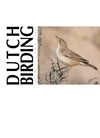Dutch Birding volume 33 (2011) no 4

Daurian Starling on Vlieland in October 2005
On 11-12 October 2005, a first-year male Daurian Starling Agropsar sturninus was observed on Vlieland, Friesland, the Netherlands. It was mostly seen with a large group of Common Starlings Sturnus vulgaris which also held two Rosy Starlings Pastor roseus. Ageing was based on the brown juvenile tertials and inner secondaries contrasting with two black adult-type tertials, as well as the pale bill base. Sexing was based on the blackish primaries, tertials and wing-coverts, and black nape-patch.
After much debate concerning its status, the bird was accepted as the first record for the Netherlands and the second for Europe and the Western Palearctic (after one in Norway on 29 September 1985). The Dutch rarities committee (CDNA) considered natural vagrancy to Europe possible for this species (which probably breeds west to Lake Baikal, Siberia, Russia, and undertakes fairly long-distance migration). Two previous records in the Netherlands (15 May 1999, Den Oever, Noord-Holland, and 5 November 1999, Duiven, Gelderland) which had been regarded as presumed escapes (identification accepted) by the CDNA were reviewed. After several rounds, the rejection (on status) of both 1999 records was reconfirmed for the following reasons: (Den Oever) 'identification accepted; however, because this species is such a rare vagrant in north-western Europe (and was, at the time, known to be frequently held in captivity), the CDNA wanted to be absolutely sure about the state of the bird's plumage and bare parts; this bird was seen for 3-4 min sitting in a bush and was not photographed. The CDNA is not convinced that all critical details regarding the bird's plumage and state of the bare parts have been seen and so, after extensive discussion, this record was rejected'; (Duiven): 'identification accepted; however, because this species is such a rare vagrant in north-western Europe (and was, at the time, known to be frequently held in captivity), the CDNA wanted to know more about the state of the bird's plumage and bare parts and its behaviour towards humans, which proved impossible to retrieve; only one poor photograph is available of this individual'.
Three records in Britain (May 1985, August-September 1997 and September 1998) have all been rejected as presumed escapes, based on the presumed low 'vagrancy potential' and status in captivity.
Max Berlijn, Wilhelminastraat 9, 6285 AS Epen, Nederland
(max.berlijn ing.nl)
ing.nl)
Jan van der Laan, Brouwerstraat 19, 1814 HX Alkmaar, Nederland
(j.vdlaan xs4all.nl)
xs4all.nl)
terug






